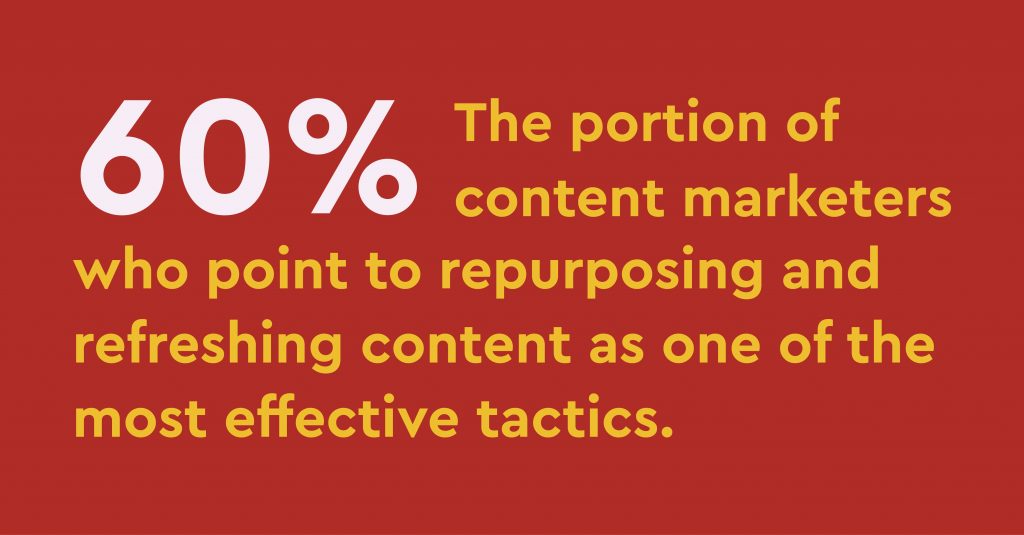
You’ve probably heard of the “Marketing Rule of 7” that says that an audience needs to hear a message seven times before they will convert. It’s a really old rule (some say from the 1930s) that might be based on Jello versus data, but overall we know the essence of it is true. Do you ever just publish and promote once and then see traffic go through the roof and watch the leads rain in?
Um…no you do not.
You have to remind your audience what you’re about, what you know, what you sell, and why they need it over and over again. You could do that with brand new, fresh content daily. But we all know that’s a big lift and if you move on right after you publish, you’re leaving money on the table. That’s why more than 60 percent of content marketers point to refreshing and repurposing content as one of the most efficient tactics they use, only behind search engine optimization. If you’re part of that 60 percent, maybe you think you don’t need to keep reading. But you do!
What is repurposed content — and why do you need it?
Repurposing content is the way to get the most out of what you create — and the most efficient way to get your message in front of your audience so that it sinks in. Essentially, it means you’re taking existing content and changing its format, revising it to target different audiences, or shifting it to address different stages of the sales funnel.
It keeps you from getting stuck on that hamster wheel of creating something new every day. And repurposed content also helps you expand your reach. A variety of content formats for the same topic allows you to appeal to the differences in your audience’s preferences. Not everyone will read a blog post, but with each new format you produce from that initial piece of content, you attract more audience: the video viewers, the infographic lovers, the social media scrollers. You’ve now surrounded your audience rather than banking on the notion that they will all read and love that one fabulous blog post you wrote.
Does repurposing content benefit your SEO efforts?
Repurposing content can also help you with SEO. Google favors authoritative content that offers value to readers. If you create several quality pieces of content around one subject, search engines register that you are an authority on the subject.
So if you’re already getting all the basics right, could you get even MORE out of that content you have? Yes, you certainly can. The keys? Choose the right topics and be creative about your formats (yes, you can probably expand beyond what you’re currently doing). Here are some tips:
How to choose what to repurpose
Choose topics to repurpose based on how they’ve performed in the past. It’s pretty easy to get a handle on where to start. Pull a list of the top performing content out of GA. Focus on the evergreen topics you’ve done and put those on your repurpose list. Also keep an eye out for groups of similar subjects that have pushed a lot of traffic to your site. They can be combined to create a guide or an eBook. Remember, while you’re revamping content, update the content. The fresher, the better. Refresh sources, remove dated references, change sections you’ve revised your thinking on.
Then consider what content formats resonate with your audience. Repurposing a previously successful topic into a content format that your audience just doesn’t connect with won’t work. If you know that your target audience LOVES video and short-form content, don’t delude yourself into believing that they will read a 20-page white paper just because they engaged with that topic in another format. The audience is still the audience regardless of how crafty you’re being with your repurposing.
Does repurposing content create duplicate content?
At some point you will run into the situation where you know you’re using content that already exists on your site somewhere else. It’s bound to happen. A lot of people worry about this and think that it will cause massive duplicate content penalties from the Google gods. The answer is that you only get yourself into trouble for duplicate content if you’re doing it maliciously. Like don’t steal other people’s work and paste it verbatim into your website or blog post. Doing that on the internet is no different than copying a page from the Encyclopedia Britannica (anyone remember that?) and telling your teacher you wrote it. It’s plagiarism and it’s stealing. If you are promoting your own work in different places and being smart about how you do it, Google will not penalize you for it.
A real-time content repurposing example
You’ve chosen some pieces to repurpose, calmed down about the duplicate content issue, and now you’re ready to get going. What, exactly, do you create from that great blog post you wrote?
Let’s say that after this piece is published, it becomes one of Right Source’s top performers (um, duh, of course it will). Here’s what we will make (or already have made) out of it and why:
- A graphic video. We’ve had great success creating 30-second videos from existing content for our clients and ourselves. They perform better on social media than most other content and blog posts with video attract as many as three times as many inbound links as posts without video.
- A short do-it-yourself video. A couple years ago, Right Source CEO Mike Sweeney and I did a video related to my original post on repurposing content. It was quick and easy to knock out and is now embedded in that original post. We’ll create another one to touch on some of the points from this post. It will live on our YouTube channel, can be used in future (or past) posts about content creation or getting the most value out of your work, and will be great to use as additional promotion on social.
- Audio clips. Take a few snippets from that DIY video and turn them into short audio clips for use on social media. Just use the audio if you want and create a graphic to go with it.
- An email to clients containing yet another DIY video recorded just for them. Right Source has an “insiders-only” email that we only send to our clients and partners. The next one will include this blog post, some insights about why we wrote it, and a video from me elaborating on one or more of the post’s important points. I can record it while I’m making the video I mentioned in the previous bullet. These emails have great open and click-through rates because the audience knows us and we are clear that we are offering custom information just for them. You can do the same thing. Try an insider’s message from your CEO with a video just for your most treasured clients.
- Quote graphics for social media. Grab a couple of compelling quotes or statistics from your content and make them into a quick graphic for social media. We’ll entice readers with something clickable and drive them back to this post. These are not complicated and don’t take long to create but will stand out in a social feed when they roll by.

- Infographic. We’ll create one that illustrates these points and in combination with some of the data points from our original repurposing post. We sometimes do a bit of additional research to bolster this type of piece. It’s worth it. Infographics perform well on social media and are very sharable. In fact 65 percent of brands use them.
- Tip sheet. Sometimes these are called checklists or downloadables, but whatever you call them, the premise is simple. You take the content from something that is set up as a list, skinny it down a bit, and design it as a one-page PDF. This one could be as easy as “8 Ways to Repurpose One Blog Post.” Boom. You can house it in your website’s resources section and even put it behind a form as a CTA in other posts.
- eBook. We have two repurposing posts now, but we also have posts about how to generate new topic ideas, as well as how to write the best white paper, remarkable blog posts, and the best case study. We can weave all of those together into an ultimate guide to repurposing content.
Ok, so that’s eight pieces of content out of a blog post. And if I count additional social posts that we did to promote this piece, I’m at more than 10. If you can get 10 out of a blog post, think what you can do with a white paper or a podcast or a webinar.
Don’t forget to refresh and optimize
While it’s not necessarily repurposing content, remember that it can be extremely beneficial to update and optimize your older content. Maybe you’re targeting a slightly different keyword now, or perhaps the statistics need to be updated and the post published with a new date. It can all have a positive impact on your SEO, gets more value out of that existing content, and is a pretty easy lift. (And don’t forget to repromote that refreshed piece again.)
Get more out of what you’re already doing by making repurposing content part of your ongoing strategy.
Want to learn more about cutting through the clutter with remarkable content? Read our eBook to learn what you need to set your content apart, including:
- Selecting the right topics
- Using design to make your content stand out
- Writing engaging and error-free copy
Download How to Create Remarkable Content now!


